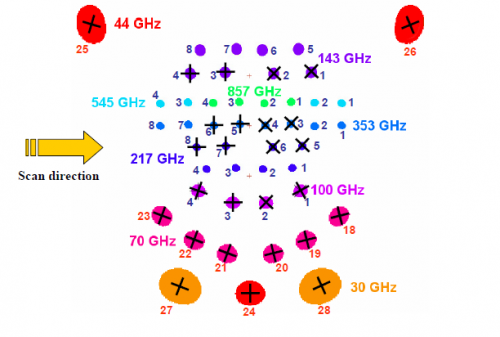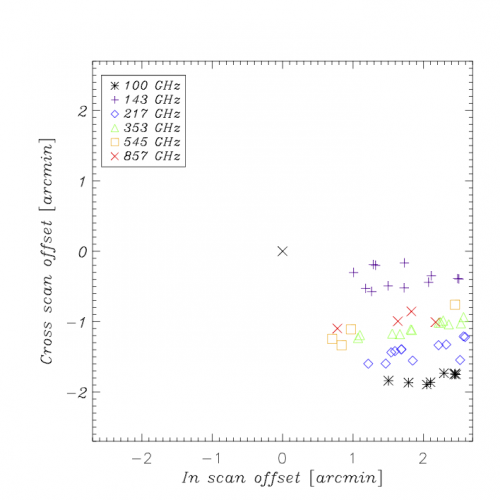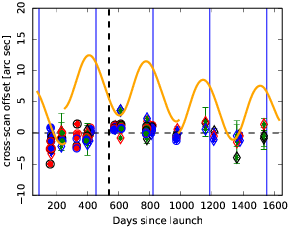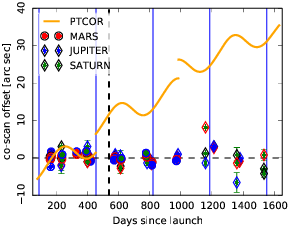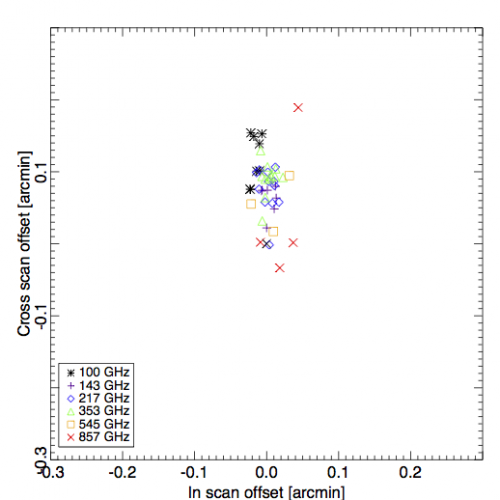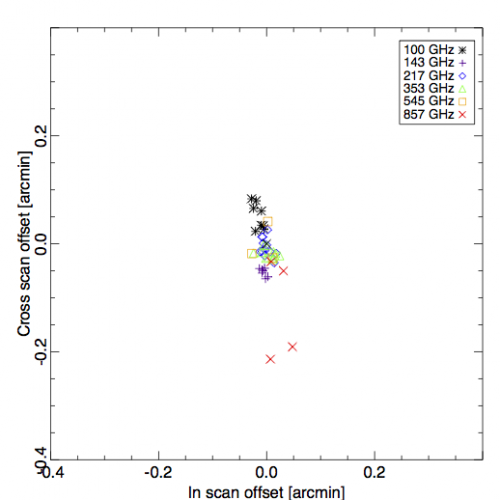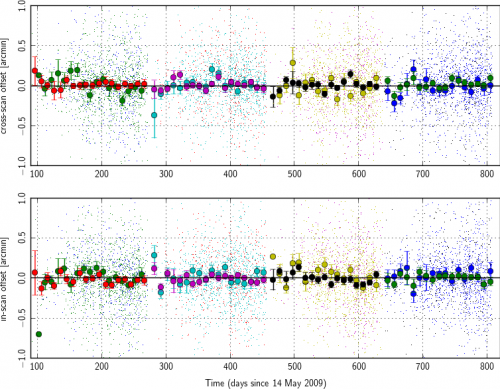Detector pointing
Contents
[hide]Introduction and Summary[edit]
The overall geometry of the Planck focal plane is shown here:
In order to take full advantage of the Planck beams, we must know the individual detector pointing positions to a precision of better than several arcseconds, over the course of the entire mission.
Spacecraft pointing comes from the on-board star tracker sampled at 8 Hz between repointings (Attitude History File, AHF). This is translated via a series of three-dimensional rotations to a pointing for the centre of the focal plane and resampled to the HFI or LFI TOI data rate for convenience. We must then further rotate this focal-plane boresight pointing to the individual detector locations. Because neither the rotations from the star tracker to the boresight nor those from the boresight to the individual detectors are known exactly a priori, we must calibrate them using flight data.
Specifically, measurements of HFI and LFI detector pointing are based largely on observations of the brighter planets, with information from the much more frequent observations of lower-flux Galactic and extragalactic high-frequency sources used to monitor and build a model of overall pointing drift. This long-term drift of the spacecraft attitude is due to changes in the moment of inertia of the spacecraft, and also includes specific events which may induce sudden changes, essentially random as far as our ability to predict their effects is concerned. In this delivery HFI used a model (described below) to follow the pointing drift continuously, while LFI uses two different focal plane descriptions for the two time periods separated by operations perfomed on the instrument that modified the thermal behaviour. The two approach are consistent to better than a few arcsec.
Note that for HFI the resulting pointing model cannot easily be directly compared to a physical/optical model: in particular, it includes a phase shift in the scan direction from the convolution and deconvolution of the detector transfer function, which is complex in the Fourier domain (see Planck-2013-VII[1]). This phase shift was not measured during normal operations, but a short campaign during which the spacecraft was spun at a higher rate will be used to determine these offsets in future date releases. Comparison with the initial optical model indicates that the in-scan change due to this phase shift is of the order of 1 arcminute. Note also that aberration is corrected in all observations.
The final pointing model is measured to be better than 2 arcsecond rms in the co-scan and cross-scan directions averaged over ten-day periods, as shown below. Note that there are larger hourly drifts of up to 10 arcseconds due to interference from the radiometer electronics box assembly (REBA) as discussed more fully in Planck-2013-VI[2].
Stellar Aberration[edit]
The corrected quaternions are interpolated using Spherical Linear Interpolation algorithm and transformed in cartesian vector, which we call . For each sample the stellar aberration correction is applied:
where is the satellite velocity and is the speed of light. After this operation the vector is normalized.
Finally the cartesian vetor is converted in Ecliptic Coordinates, the detector pointing.
Beam Rotation[edit]
The rotation of the beam with respect to North is the angle and is computed rotating the corrected quaternions using:
The resulting rotation matrix represents the rotation of the beam, the angle is then:
Initial measurements: Mars 1 and other planets[edit]
The first observation of Mars, which occured around 180 days from launch, is the baseline against which other objects are compared. Here, we show the relative pointing of Mars 1 to the pre-launch RFFM.
Focal plane drift[edit]
The low frequency pointing correction, known as PTCOR has been reworked to include satellite "wobble" angle corrections (difference between the satellite spin frame and the rigid body reference frame). The move was necessitated by problems in the measured wobble angles beyond the HFI mission (beyond survey 5). We also observed that the long time scale features in the pointing correction were very well fitted by a template constructed from the solar distance. This template was further augmented by including a linear fit component and breaks at times of known thermal disturbance onboard the spacecraft.
A model for Planck HFI Pointing[edit]
These analyses allow us to build a model for the pointing drift. The following describes the procedures used for the HFI detectors.
The correction is based on the measurement of pointing offset directly from the timeline, on a small sample of known and bright radio sources and planets. First the beam shape of each detector is measured by stacking individual timeline observation of bright planets. This process is of course contaminated by pointing error, but this is reduced by allowing each pass on the planet to be slightly displaced in order to correct for the observed location of the planet. This process yields a very clean estimate of the beam of each detector.
Those beams are then used to determine the offset of the observed location of the planets (Mars, Saturn, and Jupiter) and of a few (~10) bright radio sources. These offsets are estimated using detectors at all frequencies for the planets, and only at 100GHz, 143GHz and 217GHz for the radio sources.
From the planet observations, one can recover the alignment of each detector in the focal plane, as well as a first pointing correction measured at the times of individual planet crossings. This pointing correction is obtained by fitting splines on the planet observation from each detector. We further allow this correction to have a sharp jump between the second and third survey (the time of the SCS switchover on OD 455).
This first pointing correction is further refined (at the lower HFI frequencies only) using the point sources observations in order to fill the period between planet observations. The radio source offsets require further treatment than the planet based offsets. First, the brightness of the sources being much smaller than planets, the offset on individual detector observation are very noisy, and we filter out the noise by building median offsets for each point source observation. Second, since the sources can be slightly extended we still observe systematic offset above and below the planet based pointing correction in a regular alternating pattern. This is due to the fact that we are observing those extended objects scanning in alternating directions, and our fit of those extended sources to our beam translate into this systematic alternating pattern. We thus allow for a small, arcsec correction of those offsets: i.e., each object is allowed a single offset displacement of order arc seconds in order to minimize the offset between different observations of the same object at different time.
The resulting list of point source offsets is then merged with the planet offsets. Again a spline based correction is built fitting all of this data, and allowing rupture of continuity at the time of the SCS switchover and other major onboard event (typically between each surveys).
Once we assume the full Planck pointing model and re-measure the position of Mars for this observation, we see sub-arcsecond deviations (as expected); this gives an indication of the purely numerical limitations of the method. Further planet observations show the small remaining uncorrected drift present in the pointing model (note that cross-scan positions are measured with considerably less data than in-scan positions due to the scan strategy):
Redoing the single-survey map- and catalog-based computation with the corrected pointing shows that Planck has achieved the arcsecond-scale rms uncertainty of pointing:
A model for Planck LFI Pointing[edit]
The profiles and locations of the beams are determined from the four observations of Jupiter listed in Table 1. Details are given in Planck-2013-IV[3].
| Jupiter transit | Date | OD |
| Scan 1(J1) | 21/10/09 - 05/11/09 | 161-176 |
| Scan 2(J2) | 27/06/10 - 12/07/10 | 410-425 |
| Scan 3(J3) | 03/12/10 - 18/12/10 | 569-584 |
| Scan 4(J4) | 30/07/11 - 08/08/11 | 808-817 |
The origin of the focal plane is the optical line of sight defined in Planck-PreLaunch-II[4]. In the LFI RIMO, the beam centres are given by four numbers, , , , and . Only and , which are the beam pointing in spherical coordinates referred to the line of sight, can be determined with Jupiter observations. The polarization orientation of the beams, defined by , is not estimated from flight data but is derived from main beam simulations based on ground measurements.
For each beam, the pointing is determined by the location of the maximum of an elliptical Gaussian fit to that beam. This was done for each beam in each single scan. Results are reported, with errors, in Planck-2013-IV[3]. In addition, the beams are stacked in pairs (J1+J2 and J3+J4) and all together (J1J2J3J4) in order to improve the signal-to-noise ratio of the measurements. Before the stacking, each beam is artificially repointed along the direction given by the arithmetic average of the centre of each beam to be stacked. Then a fit is performed again on the stacked beams and the resulting parameters recorded. For single scans it has been found that there is an agreement within 2 arcsec in the pointing direction between J1 and J2. The same agreement occurs between J3 and J4. In contrast, a 15 arcsec systematic deviation of the beam centre was detected when comparing J1+J2 to J3+J4. The figure below shows the reconstructed beam positions and errors in the line-of-sight frame magnified by a factor of 100. The shift is evident for the 70 GHz beams, as well as in all the J1+J2 and J3+J4 stacked beam centres. The change in the pointing has been found mainly in the scan direction (i.e., -coordinate). To account for this pointing shift, we apply two pointing solutions for LFI. The first focal plane calibration is valid from OD91 to OD540 and is based on the J1+J2 beam pointing determination. The second calibration is valid from OD541 to OD563 and is based on the J3+J4 beam pointing calibration.
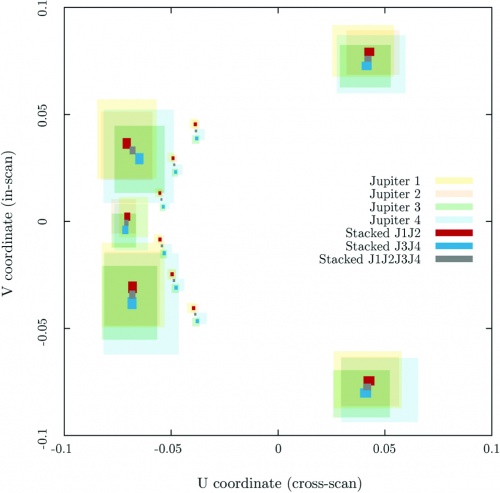
References[edit]
- Jump up ↑ Planck 2013 results. VII. HFI time response and beams, Planck Collaboration, 2014, A&A, 571, A7.
- Jump up ↑ Planck 2013 results. VI. High Frequency Instrument Data Processing, Planck Collaboration, 2014, A&A, 571, A6.
- ↑ Jump up to: 3.03.1 Planck 2013 results. IV. Low Frequency Instrument beams and window functions, Planck Collaboration, 2014, A&A, 571, A4.
- Jump up ↑ Planck pre-launch status: The optical system, J. A. Tauber, H. U. Nørgaard-Nielsen, P. A. R. Ade, et al. , A&A, 520, A2+, (2010).
Attitude History File
(Planck) High Frequency Instrument
(Planck) Low Frequency Instrument
LFI Radiometer Electronics Box Assembly
sudden change of the baseline level inside a ring
Sorption Cooler Subsystem (Planck)
Operation Day definition is geometric visibility driven as it runs from the start of a DTCP (satellite Acquisition Of Signal) to the start of the next DTCP. Given the different ground stations and spacecraft will takes which station for how long, the OD duration varies but it is basically once a day.
reduced IMO
